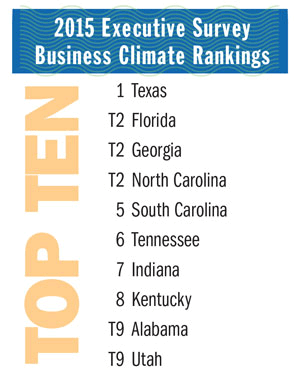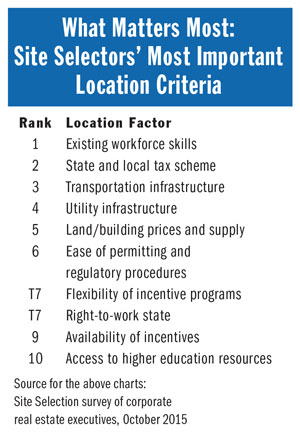It’s hard to stop a train, and the train called Georgia is on cruise control. For the third year in a row, the Peach State takes first place in Site Selection’s annual ranking of state business climates, a closely watched barometer of which states have the right mix of actual project successes and high favorability as indicated by site selectors. It’s watched closely because it reflects announced capital investment projects reflected in the Conway Projects Database and several other objective measures of state attractiveness (see the methodology on page 98). Qualified capital projects are private-sector only and meet one or more of these criteria: $1 million or more in investment, 20 or more new jobs or 20,000 or more square feet of new construction.
North Carolina placed second, up from third place last year. The Tar Heel State risks losing its status as the only state to win four times consecutively in recent years – which was just prior to Georgia’s current run of three back-to-back wins. Rounding out the top five are Kentucky in third place (up from eighth in 2014), Louisiana and Ohio.
Half the overall ranking is based on a survey of corporate site selectors asked to rank their top 10 state business climates based on their experience of establishing or expanding facilities in them. At 50 percent, states need to do very well in this exercise to make it into the winners circle. Texas finished first, followed by Georgia, North Carolina and Florida tied for second. South Carolina rounds out the top five. Outside the Southeast, only Indiana and Utah make the top 10 — in seventh and ninth places.
Utah finished eighth in the overall business climate ranking. From the Midwest, Ohio and Indiana also made the top 10 — fifth and ninth place respectively — reflecting these states’ leaders’ efforts in recent years to transform, diversify and grow their economies. The rest of the best in both the overall ranking and survey component are in the Southeast, proving again in 2015 that the region dominates in attracting corporate facilities and expansions. And the heart of the Southeast and home of its largest metro area, Atlanta, is Georgia, which beat not just other Southeastern states, but all states for its third consecutive Top Business Climate ranking. How?
| Overall Ranking Rank | State | Executive Survey Rank | Competitive Survey Rank | 2014 NP Rank | 2014 NP Rank PC | 2015 NP Rank | 2015 NP Rank PC | Mature Firm TI | New Firm TI | Final Total Points |
|---|---|---|---|---|---|---|---|---|---|---|
| 1 | Georgia | 2 | 10 | 5 | 7 | 2 | 6 | 3 | 6 | 637 |
| 2 | North Carolina | 2 | 1 | 4 | 6 | 1 | 4 | 7 | 15 | 615 |
| 3 | Kentucky | 8 | 6 | 6 | 1 | 7 | 1 | 18 | 7 | 585 |
| 4 | Louisiana | 13 | 2 | 9 | 3 | 8 | 2 | 10 | 2 | 576 |
| 5 | Ohio | 11 | 9 | 2 | 2 | 5 | 12 | 5 | 3 | 573 |
| 6 | Texas | 1 | 3 | 1 | 14 | 18 | 41 | 12 | 42 | 553 |
| 7 | Tennessee | 6 | 5 | 10 | 9 | 10 | 10 | 29 | 29 | 531 |
| 8 | Utah | 9 | 17 | 28 | 19 | 30 | 26 | 6 | 10 | 528 |
| 9 | Indiana | 7 | 8 | 12 | 13 | 3 | 3 | 43 | 15 | 525 |
| 10 | South Carolina | 5 | 4 | 17 | 11 | 11 | 9 | 32 | 34 | 517 |
| 11 | Alabama | 9 | 19 | 18 | 16 | 16 | 15 | 13 | 19 | 492 |
| T12 | Oklahoma | 18 | 20 | 25 | 21 | 12 | 7 | 16 | 5 | 491 |
| T12 | Virginia | 15 | 13 | 11 | 18 | 4 | 8 | 11 | 39 | 491 |
| 14 | Florida | 2 | 15 | 14 | 41 | 13 | 32 | 19 | 36 | 486 |
| 15 | Arizona | 12 | 23 | 22 | 30 | 15 | 21 | 14 | 31 | 454 |
| 16 | Michigan | 19 | 7 | 7 | 17 | 6 | 11 | 25 | 25 | 435 |
| 17 | Nevada | 13 | 11 | 33 | 31 | 46 | 46 | 4 | 38 | 429 |
| 18 | Mississippi | 15 | 30 | 31 | 25 | 22 | 19 | 37 | 21 | 420 |
| 19 | Iowa | 21 | 22 | 23 | 10 | 21 | 18 | 40 | 41 | 398 |
| 20 | Minnesota | 21 | 31 | 21 | 24 | 19 | 22 | 39 | 35 | 376 |
| 21 | South Dakota | 30 | 35 | 34 | 5 | 35 | 14 | 2 | 11 | 371 |
| 22 | Arkansas | 21 | 33 | 29 | 20 | 37 | 36 | 30 | 8 | 367 |
| 23 | Missouri | 21 | 21 | 20 | 26 | 31 | 37 | 36 | 26 | 356 |
| 24 | Colorado | 15 | 40 | 30 | 33 | 26 | 31 | 33 | 47 | 355 |
| 25 | Illinois | 30 | 12 | 3 | 8 | 8 | 17 | 45 | 24 | 353 |
Getting the Policies Right
“Capital investors tell us the ideas we put in place are actually working,” Gov. Nathan Deal told Site Selection Editor Mark Arend in an October 7th interview. “We tried at the very beginning to do what government can do, and that is to get its policies right. Our tax reform in the manufacturing arena, for example, to remove the sales tax from energy use was a huge boost to our manufacturing sector. Another was to remove as many regulatory impediments as possible. Those are important things government can do.
“Another is to provide a well-educated and trained workforce, and that is becoming more and more of a signature issue as investors look at our state,” says Gov. Deal. “They like the things we have done in terms of basic reforms. But they especially like the fact that we’ve always had a very good higher education arena in terms of our colleges and universities. Our technical college system has always been one of the top systems in the country, as is our Quick Start [workforce training] program for existing companies and newcomers to the state.”

Now, says the governor, the focus is shifting to the pre-college years.
“We’ve now put our emphasis earlier in the system — we already have one of the better pre-K programs in the country. Part of our agenda this next legislative session will be to try to increase the salaries of pre-K teachers and to make sure they have qualified and well-paid assistants to work with them. That’s the beginning of the process. We’ve also put more emphasis on the first three years of school, to make sure that at the end of third grade, those children are reading at the third grade level. We’re having great success with that.”
Gov. Deal also points to “significant reforms” elsewhere in the pre-college education spectrum, and not just in funding levels, though he says more money as a percentage of the state budget is going to education now than under any governor for the past 50 years. “Of course, the General Assembly has had a major role in appropriating that money,” Gov. Deal acknowledges, adding that an education reform commission is already crafting recommendations for the next legislative session.
Why such a focus on early childhood, middle and high school education now?
“It is an essential part of having a good workforce,” says Gov. Deal. “The reforms we’ve made on the high school level — initiatives for helping students be able to move on when ready and funding of dual enrollment programs, for example — are seeing participation rates that are double what we anticipated for this current fiscal year. We’ve adopted the European model of apprenticeships, and that’s something the European companies that are investing here welcome, because they are accustomed to it. We will continue to try to address any impediments that exist with regard to apprenticeships. Workers’ comp is one of those issues we have to address in that context, and we will deal with that.”
That’s a Wrap
Georgia’s HOPE grant program makes available 100-percent tuition scholarships to students seeking degrees or certificates at a state technical college in one of 11 disciplines identified by state businesses as being in need of workers. A recent addition to the list benefits Georgia’s booming film industry, training in-state workers so that production companies don’t need to import those workers when they come to Georgia to shoot, say, “Ant-Man,” which was filmed in Georgia and opened in theatres in July. The movie, starring Michael Douglas and Paul Rudd, employed 3,579 Georgians, spent more than $106 million in Georgia and required 22,413 hotel rooms during filming. In addition to filming at Pinewood Atlanta Studios, “Ant-Man” shot scenes in Atlanta including the state-owned Archives Building, Bank of America building and on Broad Street.
On July 9th, Gov. Deal announced that Georgia-lensed feature film and television productions generated an economic impact of more than $6 billion during fiscal year 2015. The 248 film and television productions shot in Georgia represent $1.7 billion in spending in the state.

“Georgia’s film industry has had a significant impact on our state,” said Deal. “These statistics represent job creation, increased business opportunities and the revitalization of communities statewide, and I am committed to building a strong film-ready workforce in Georgia to ensure that the industry continues to flourish here.”
In September 2014, the governor announced that all of Georgia’s 159 counties had been designated “Camera Ready” — a designation given to communities interested in cultivating and attracting the entertainment industry. Camera Ready communities name liaisons who can assist film and television production companies on a local level. The industry employed nearly 78,000 Georgians at the time.
More recently, Deal established the Georgia Film Academy, earlier in 2015, bringing together the University System of Georgia, the Technical College System of Georgia and members of the film industry to collaborate. Working together, they established a program to provide students with degrees or certifications that fulfill industry needs and demands. On the television side, Georgia already is a leading (the leading, by some measures) state for production work thanks in part to its trained workforce and abundance of nonstop flights to Los Angeles.

Gov. Deal says a key lure is “permanency for the film industry, such as the Pinewood Studio in Fayette County and multi-million-dollar investments in capital projects of that nature. Those are not projects that are going to pick up and go somewhere else.” Tyler Perry Studios in southwest Atlanta has five sound stages, a post-production facility, theatre and other production assets. Raleigh Studios Atlanta has four sound stages, mill space, a cyclorama and other production features. On the drawing board is a 5 million sq. ft. (464515 sq. m.) Atlanta Media Campus & Studios being planned by Jim Jacoby on a site in Gwinnett County.
“Georgia is one of the fastest-growing entertainment production centers in the world with 42 productions currently filming across the state,” said Chris Carr, commissioner of the Georgia Department of Economic Development (GDEcD). “More than 100 new businesses have relocated or expanded in Georgia to support the industry — creating jobs for Georgians as well as economic opportunities for our communities and small businesses — ensuring Georgia’s place in the industry well into the future.”
Meanwhile, Georgia increasingly is on the radars of global companies seeking a new or different North American base of operations, particularly in the automotive industry. In May, Porsche Cars North America officially opened its $100-million Porsche Experience Center and headquarters on a 27-acre (10.9 hectares) site adjacent to Hartsfield-Jackson Atlanta International Airport. The site features a 1.6-mile driver development track, classic car gallery, restoration center, simulator lab and a restaurant — not to mention office space for Porsche’s Financial Services, Business Services, Consulting and other business units. In February, Mercedes-Benz USA announced a relocation of its headquarters from New Jersey to a site in Sandy Springs, Ga., where it will fill hundreds of positions once the $100-million campus is complete in 2017.

Asked about foreign perceptions of Georgia he observes on international trade missions, Gov. Deal says he hears mostly about Coca-Cola and Georgia Tech — two Atlanta-based household names, the latter due to Yellow Jacket engineers at work at companies around the globe. “Now, with companies like Mercedes-Benz and Porsche establishing their North American headquarters here, that gives even greater recognition and significance to Georgia,” says the governor. “We continue to see Fortune 500 and Fortune 100 companies calling Georgia home. Companies like these, especially when they are foreign-based initially, become our ambassadors in their own countries. Whether it’s Kia with their manufacturing facility in our state — they have brought literally thousands of other jobs here with their supplier base. They have encouraged their suppliers to come to Georgia. The same is true of Mercedes-Benz and Porsche. When they put their stamp of approval on Georgia, as they have done, that gives us greater credibility and a broader recognition around the world.”
Sectors to Watch
Georgia’s IT sector is a leading and growing industry and will be for some time, says Gov. Deal, who recently visited Atlanta-based Home Depot’s new, 200,000-sq.-ft. (18,580-sq.-m.) Marietta Technology Center built to house 1,000 IT associates initially, with room for 500 more. Georgia also is home to a new Hope Depot direct fulfillment center, which opened in Locust Grove in 2014, and an online customer service center in Kennesaw, which opened in 2012.
“We are already a leader in the IT financial services arena — about 70 percent of all electronic transactions in the United States pass through the State of Georgia,” says the governor. “We also know the cybersecurity arena will be an ever-evolving field. The US Army moving its Cyber Command from Maryland to Fort Gordon in Augusta is already producing results in the private sector. Many of the contractors and suppliers to the Cyber Command are relocating to Georgia as well. We are excited about the whole scope of the IT arena.”
According to GDEcD figures, the state’s software and technology industry grew new job opportunities by 128 percent and increased investment by 219 percent in FY15 compared to the previous year. Overall, GDEcD says its Global Commerce division helped create 26,951 new jobs and $4.75 billion in FY15.
Georgia’s business climate remains attractive to automotive industry investors, says the governor, noting the addition of two German suppliers to Georgia’s FDI rolls gained on a recent trade mission to Germany. NIFCO KTW, a German automotive supplier of high-quality injection molded components, will locate its US operations in Toccoa, Stephens County, creating 200 jobs and investing $27 million within the first five years. The company, based in Weissenburg, Germany, is a supplier to Mercedes-Benz, BMW and others. As the company’s first North American headquarters, NIFCO KTW will build an initial 130,000-square-foot facility (12,000-sq.-m.) on 32 acres (13 hectares) of Georgia Ready for Accelerated Development-certified land at Hayestone Brady Business Park. The company also has intentions of expanding this site in the future. NIFCO KTW will also plan to take advantage of QuickStart to provide customized training to the new employees.
Sandler AG, a German textile supplier, will complete construction of a manufacturing plant in Perry. This represents an investment of more than $30 million and will create more than 140 new jobs in Houston County. Sandler is a privately held, family owned company that supplies textiles to international manufacturers, including a number of American Fortune 500 companies. The new Georgia facility will function as a production plant, warehouse and base for national sales and distribution. Sandler will begin recruiting employees and filling jobs for the facility in early 2016.
Other recent Georgia projects of note include:
- ADP (cloud-based HR management) is investing $20 million, creating 450 new jobs in Augusta;
- Alcon (contact lenses and supplies) is investing $275 million and adding 300 or more new jobs in Johns Creek, where is has created 550 jobs and invested $500 million in since 2013;
- Suniva (silicon solar cells and modules) is investing $96 million in Gwinnett County and creating up to 500 new jobs;
- Vanguard National Trailer Corp. (semi-trailers) is investing $30 million in Dade County where it is creating 400 jobs; and
- Brazil-based Stefanini (IT services) will create 400 new jobs through 2016 through an expansion of its Atlanta operations.
“We’ve been very fortunate,” says Gov. Deal. “We wound up fiscal year 2015 with a growth of about 6.4 percent in revenue over fiscal year 2014, and our budget was based on 3.6 percent growth. So we’ve put a huge amount of money from that differential into our rainy day fund. We believe that when everything is accounted for in fiscal year 2015, our rainy day fund will be somewhere close to $1.3 billion, and it was virtually depleted when I came into office. Our goal is to get it to about $2 billion by the time I leave office. For a state our size, our bond rating agencies say that is an area where they would feel more comfortable with us being in, and we’re getting there in a hurry. We’ve maintained our AAA bond rating through all of this, and I know that saves us a lot of money in interest on our bonds.”
Ranking Methodology
Fifty percent of the overall Business Climate Ranking is based on a survey of corporate site selectors who are asked to rank the states based on their recent experience of locating facilities in them.
The other 50 percent is based on an index of seven criteria: performance in Site Selection’s annual Competitiveness ranking; total New Plant Database compliant facilities in 2014; total new facilities in 2014 per capita; total 2015 new projects year to date; total 2015 projects year to date per capita; state tax burdens on mature firms and on new firms according to the Tax Foundation and KPMG Location Matters analysis.
Sound fiscal health is a sign of strong leadership, particularly in challenging economic circumstances. Even more challenging is being able to offer — and then delivering on — what capital investors most require, which is predictability — the feeling that their long-term investment in a location is a wise investment today and will be so in the future.
“The main question to me from the film industry always is, ‘Can we count on the tax credits being there over a longer period of time?’ My answer to them is, ‘The best way you can be sure that a state will maintain what you consider to be important to you is to have a state with its finances in order.’ If you ever get in trouble with state finances and sustaining the functions of government, when you’re pitted against education, you will always lose. Some states have had to cut back on their tax credits to the film industry, and Georgia has benefited. It’s predictability and stability, and investors want to be able to count on it for more than one legislative session. It’s smart for them to think like that, and it’s smart for us to understand that.”

